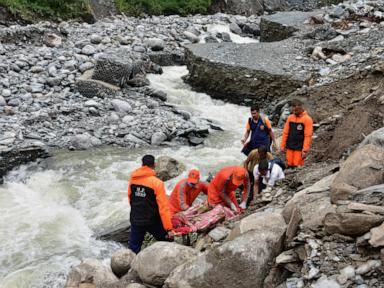

Torrential rains in the northern Indian state of Himachal Pradesh have triggered a devastating flash flood, leaving at least three people dead and a dozen others feared missing. The incident occurred in the Kangra district, approximately 18 kilometers (11 miles) from Dharamshala, a popular tourist destination known for its Tibetan culture and as the home of the Dalai Lama.
Local authorities have launched a rescue operation to locate those who were swept away by the sudden surge of water. Dinesh Sharma, a local government spokesperson in Kangra, confirmed the ongoing efforts to trace the missing individuals.
According to Sudhir Sharma, a lawmaker from Dharamshala, the flash flood occurred late Wednesday, when water levels in a local reservoir rose rapidly. In a social media post, Sharma reported that 15 to 20 workers who were resting in a temporary shed near a hydroelectricity power project site were swept away by the deluge.
A status report released by the state government on Thursday confirmed that at least eight people were missing in Kangra, while another three were missing in the nearby Kullu district. Authorities have been working to evacuate stranded tourists to safer locations within the state, with approximately 50 people rescued so far.
While the state government has confirmed the three fatalities, details surrounding the deaths have not yet been released. The incident underscores the vulnerability of the region to natural disasters, particularly during the monsoon season.
Flash floods and cloudbursts are a recurring threat in India's mountainous states, including Himachal Pradesh. The heavy rainfall often leads to landslides and widespread destruction, disrupting normal life and causing significant damage to infrastructure.
Critics have pointed to deforestation, driven by infrastructure development and the expansion of hydel power projects, as a contributing factor to the increased frequency and severity of these disasters. They argue that the environmental consequences of such activities need to be carefully considered, and that greater emphasis should be placed on disaster preparedness and mitigation measures. The large-scale construction and deforestation destabilize the terrain, making it more susceptible to landslides and flash floods. There have been increasing calls for environmental accountability to ensure sustainable development in these ecologically sensitive zones.
The incident serves as a stark reminder of the challenges faced by communities living in the Himalayan region, where the impacts of climate change and unsustainable development practices are increasingly evident. The need for improved early warning systems, better infrastructure planning, and a greater focus on environmental protection has never been more urgent. As rescue efforts continue and authorities assess the full extent of the damage, the focus will also need to turn to addressing the underlying causes of these disasters and building more resilient communities.